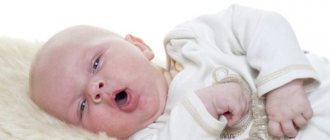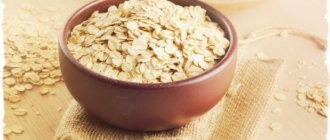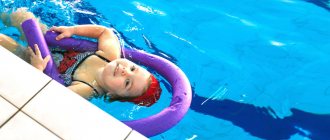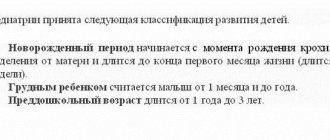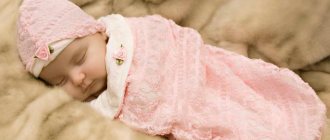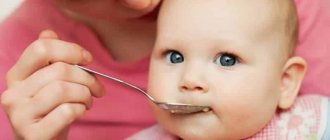In the first weeks and months of a child’s life, parents try to protect him from all sources of infection. No matter how hard they try, the baby still develops sniffles. Why is this happening? This article will tell you what a physiological runny nose is in a baby, and whether it needs to be treated.
The main causes of runny nose in children
The cause of nasal congestion in an infant is not always a cold. There are completely natural conditions called physiological runny nose, which are not considered a disease, but only the body’s response to certain circumstances. This phenomenon can occur at any age, but there are some patterns:
- Adaptation to new conditions. During the first week of life, a baby's nasal passages adapt to their new environment, so small, clear discharge is normal. Typically, this type of runny nose lasts from one to three weeks. If during this period there is no increase in body temperature, moodiness and lethargy, then treatment is not required.
- Development of salivary glands. By about three months, the baby's salivary glands begin to actively develop. In this case, discharge is formed not only in the mouth, but also in the nasopharynx, causing a runny nose. This is also not a disease.
- Teething. Nasal congestion, sometimes accompanied by fever, can occur during teething. Active blood circulation in the gums also provokes inflammation of the nasopharynx. Usually this condition goes away without a trace after the teeth erupt.
- Unfavourable conditions. Non-cold runny nose factors that can be influenced are the unsuitable environmental conditions of the newborn. Dry air, house dust, animal hair, household chemicals - all this can trigger the development of a runny nose.
What medications can be used to get rid of crusts in a baby’s nose?
Mucus begins to actively dry out in the baby’s nose if the air in the room is too dry. Be sure to use moisturizers to prevent crusting. You can increase the humidity by placing a separate container of water next to your baby’s bed.
Before removing the crusts, experts recommend softening them using seawater-based products. Such drugs are completely safe for children and can be used at any age.
The most effective means include:
| Drugs | Photo | Price |
| Aqualor | From 121 rub. | |
| Aquamaris | From 538 rub. | |
| Marimer | From 212 rub. |
The selection of the drug depends on the age of the baby. Products containing sea salt not only clear mucus from the nose. They have an antimicrobial effect on the baby’s mucous membranes. In this way, the development of inflammation can be prevented.
In the absence of preparations based on sea water, parents begin to drip saline solution. However, such a remedy may cause irritation to the baby’s mucous membranes. The reason for this reaction is the high concentration of table salt.
If necessary, you can use herbal decoctions with an anti-inflammatory effect. You can relieve irritation with chamomile infusion.
Important! Before the procedure, consult your doctor to avoid allergies.
How to recognize physiological rhinitis
A child touches his nose
Many parents wonder: what kind of runny nose is not dangerous to health?
Physiological runny nose in an infant has the following symptoms:
- the discharge is liquid and transparent, its quantity is small;
- “grunting” sounds or snoring are observed;
- periodic nasal congestion, which may go away on its own;
- Clear snot appears when crying, taking a bath, or being in the cold.
If a newborn exhibits only the listed signs, then they do not require treatment as such. Only certain measures are possible to facilitate the evacuation of secretions.
Physiological runny nose
For children up to 2.5 - 3 months, a runny nose is a physiological condition: before this age, natural processes of adaptation of the body to existence in a new environment take place. This is also due to the anatomical features of the structure of the upper respiratory tract in children. Their mucous membrane is fully formed only by 10 weeks after birth.
If a baby has a physiological runny nose, no treatment is required - it is necessary to create comfortable conditions for the child: sufficiently moist and warm clean air in the children's room.
Predisposing factors
The structure of the nasopharynx and sinuses in an infant and an adult is significantly different. The inhaled air is exposed to:
• cleansing;
• heating;
• hydration.
Infants, unlike adults, have only 2 nasal passages: the upper and middle. The lower one is absent, its development is completed by 4 years. The missing nasal passage and the narrow lumen of the existing ones lead to the fact that the inhaled air is partially purified, moistened and heated - a runny nose (rhinitis) occurs.
Opinion of pediatrician E. O. Komarovsky
The famous pediatrician, Evgeny Komarovsky, believes that physiological snot in a newborn does not harm, on the contrary, it helps the baby. They are a protective barrier to the lungs. Thus, bacteria and dust are retained in the mucus, which prevents them from entering the respiratory tract.
Baby sleeps with mouth open
How long does physiological rhinitis last?
This condition occurs in 90% of newborns in the first week of life. For some children it may take much longer – up to several months. If the discharge causes severe discomfort to the baby, it is better to consult a doctor.
Important! A physiological runny nose can last from 1 to 12 weeks.
Is it possible to go for a walk?
Many mothers begin to worry about the slightest change in the baby’s condition and, in an attempt to protect him from a cold, do not let him go outside at all. This is wrong - you can and should go for a walk. A physiological runny nose is not a disease; fresh air will only have a positive effect on the baby’s health. Dr. Komarovsky advises walking even with a cold, if there is no fever and the weather permits.
Important! Daily walks in the fresh air help strengthen the immune system.
Possible complications
Despite the harmlessness of a physiological runny nose, you should always monitor the condition of the baby. Excessive inflammatory process threatens with complications such as sinusitis, sinusitis, otitis media and other diseases of the ENT organs.
Important! If any doubtful symptoms occur, you should consult a doctor so that treatment can be started on time if necessary.
Tips for parents
To prevent the development of complications, Dr. Komarovsky recommends ensuring that the child drinks enough fluids, has access to fresh air by ventilating the room, and takes daily walks. Excessive amounts of discharge can be suctioned out using a baby syringe or aspirator, after dropping a solution of sea salt or saline.
Causes of a runny nose
In the mother's womb, the baby receives all the necessary substances through the umbilical cord. After birth, the baby's airways are forced to adapt to an environment in which there is no fluid.
To ensure the normal functioning of the nasopharynx organs, the baby’s body begins to produce mucus. With its help, the mucous membranes of the respiratory tract are moistened.
However, when seeing heavy discharge, most parents feel worried, as they fear for the baby’s health.
When to see a doctor
If the body cannot cope with viruses and bacteria, a cold or viral runny nose begins. Under favorable conditions, such rhinitis lasts up to 7-10 days. If it does not go away within this time and thick greenish-yellow mucus appears, this indicates a bacterial infection. In this case, there is no need to self-medicate and you should consult a doctor.
Symptoms for which you should be concerned and show your child to the pediatrician:
- the nature and color of the discharge changes, the snot becomes dense and thick;
- severe nasal congestion, which interferes with the baby during feeding and sleep;
- increased body temperature and lethargy;
- loss of appetite;
- frequent stools with mucus.
Important! You can distinguish a cold by the nature and color of the discharge.
Prevention
Picture 5 Child smiling
To avoid physiological rhinitis caused by unfavorable environmental conditions, you must adhere to the following recommendations:
- The air in the room should be sufficiently humidified. This is especially true during the heating season. For the best result, it is advisable to use a special humidifier, but you can also use improvised means: wet towels, containers of water. However, there must be a balance in everything, since both dry and excessively humid air can cause a runny nose.
- It is necessary to carry out daily wet cleaning. If possible, minimize the presence of “dust collectors” such as carpets, soft toys, and decorative items.
- The air temperature in the room should not exceed +25 degrees.
- You need to ventilate the room well, using this time for walks in the fresh air.
- Use only hypoallergenic products for washing and caring for your newborn.
- If necessary, moisturize your nose with saline or sea salt-based products.
Important! For physiological rhinitis, vasoconstrictor nasal drops should not be used.
Although such a runny nose is not a disease, you need to monitor the baby’s condition and, if possible, alleviate his condition when the baby shows anxiety.
How to help your baby cope with a runny nose
Physiological runny nose cannot be treated with drugs that have a vasoconstrictor effect. Instilling such drugs into the nose will only worsen the child’s condition.
You can speed up the process of adaptation of your baby’s nasopharynx if you adhere to the following rules:
- Regularly ventilate the room in which the newborn is located. Don't neglect daily cleaning of your apartment.
- In the children's room it is necessary to maintain humidity within 50–60%.
- To achieve optimal performance, you can use a humidifier.
- The temperature in the children's room should not exceed 20 degrees.
- During illness, it is better to avoid soft toys, as dust accumulates on their surfaces.
- Regular walks in the fresh air reduce the duration of rhinitis.
A physiological runny nose is accompanied by the secretion of mucus, which clogs the nasal passages. The baby begins to form crusts, making it difficult to breathe.
To clear mucus from the nasal passages, you can use drops based on sea water.
Natural rhinitis is not accompanied by inflammatory processes in the nasal sinuses. The baby does not feel weak in the body, mucus discharge from the nose does not prevent him from leading an active lifestyle.
Active use of heating devices can cause a deterioration in the baby’s well-being, since during operation they dry out the air. Humidifiers provide more comfortable conditions for the functioning of the child's nasopharynx.
What is this?
Physiological includes a runny nose, which is natural for a child’s body in the first months of life. It appears as a result of the newly born baby’s adaptation to breathing through the nose.
While oxygen was supplied to the baby in utero from the mother's blood, the respiratory tract did not take part in the breathing process. And immediately after birth, the glands of the nasal mucosa do not function, since while in the mother’s womb there was no need to moisturize the nasal cavity.
When a child begins to breathe, there is a need to clean, warm and humidify the air entering the lungs. The glands of the nasopharynx are responsible for this, and since their work has not yet been regulated, mucus in the nose begins to be produced in excess.
As soon as the feedback is activated (the body “understands” that so much mucus is not required to moisturize the nasal cavity), mucus secretion decreases and the runny nose goes away on its own. Provided that parents do not interfere with this natural process.
Causes
Inside the mother's womb, the baby received oxygen thanks to the mother's circulatory system, which means that the work of the respiratory tract was not carried out during the process. The birth of a baby is not an automatic solution to a breathing problem: the body is not yet sufficiently adapted to change. Because of this, the glands do not perform their functions. The nasal cavity was not moisturized before, because there was simply no need for it.
Therefore, if the runny nose is short-lived, then it should not be treated. When the need arises to inhale and exhale air through the respiratory tract, there is a need for cleansing, as well as moisturizing the incoming masses. This work lies with the glands of the nasopharynx, but the child’s body is still integrating into everyday life, which is why too much mucus appears. Its excess turns into a runny nose.
Accordingly, the discharge goes away as soon as the newborn’s body finally adapts. What is mistaken for illness will go away on its own. Parents should not interfere with the naturally occurring procedure.
Symptoms of physiological runny nose in a newborn may be intensified. The following factors influence the occurrence of such a problem:
- The premises have not been wet cleaned for a long time.
- Dust accumulation on areas and objects such as carpets or toys.
- Operation of heating devices.
- Frequent ventilation of the room (the reverse will also be harmful).
- Frequent use of medications. The use of agents that affect vasoconstriction.
Symptoms
You can determine that your baby has a physiological runny nose by the following signs:
- The baby's general well-being is not affected.
- The baby is breastfeeding normally or drinking formula from a bottle.
- The baby is sleeping peacefully.
- No fever or cough.
- The discharge looks like light transparent mucus. It comes out in small quantities, but the bulk of the mucus remains in the nose.
- The child breathes freely through his nose (there is no swelling of the mucous membrane).
- During feeding, the baby begins to sniffle and “squish” with his nose.
How long does it last?
The average duration of a physiological runny nose in infancy is 8-10 weeks. Often, by the age of three months, all symptoms of this problem disappear completely. If the conditions in the room where the baby is located facilitate the production of mucus, a runny nose may go away within a few days. The optimal parameters for a newborn’s room are considered to be 50-60% humidity and a temperature not higher than +20 ° C.
If the air is too dry or there is too much dust in the room, the duration of the runny nose is prolonged.
How long does physiological rhinitis last?
The answer to this question directly depends on the regime that parents provide to the child and hygienic care. A big mistake is the use of medications - this is not only inappropriate, but also dangerous, since the wrong tactics for treating a runny nose in the first month of a baby’s life can cause chronic rhinitis, which is difficult to cure even in adulthood. If parents create the right conditions for the functioning of the nasal mucosa, regularly ventilate and moisten the room, give the child enough water (applies only to artificial children), the physiological runny nose will go away in 2-3 weeks.
In some cases, nasal discharge may continue for up to 2-3 months. This situation can be considered a relative norm, since the epithelial lining of the nasal cavity becomes fully mature approximately 3 months after the birth of the child. However, if the nasal discharge occurs constantly, and the child shows signs of anxiety or feels unwell, it is necessary to consult a doctor and rule out an allergic reaction, which can be triggered not only by pet hair or household chemicals, but also by improperly selected infant formula .
How to treat?
If a baby’s runny nose is truly physiological, the doctor will recommend providing sufficiently moist, clean and cool air in the room where the baby is. Parents need:
- Regularly perform wet cleaning to reduce the amount of dust in the room and ensure the cleanliness of the air the baby breathes.
- Remove carpets, books, soft toys and indoor plants from the newborn’s room, that is, all objects that can accumulate dust.
- Regularly ventilate the room and control the air temperature in it, maintaining it at a level optimal for the child’s breathing.
- Put the baby to bed for a nap in the fresh air.
- Instill solutions based on sodium chloride or sea water into the baby’s nose. Such solutions include saline solution, Salin, Aquamaris, Aqualor. It is important to note that such products need to be instilled, and sprays should not be used at an early age.
- Buy a humidifier that will help set the desired humidity in the room.
- If you don’t have a humidifier, hang a damp cloth around the room or place containers filled with water.
- If your baby is having trouble breathing due to a lot of mucus, you can fill the bathtub with hot water and then bring your baby in there for a few minutes so that the baby can inhale the wet steam.
In the “Children’s Doctor” program, pediatrician Dmitry Chesnov and Natalya Navrotskaya, a consultant for the care of newborns, will tell parents what a physiological runny nose is in a baby, show how to properly clean children’s noses and teach how to remove mucus from the nose using an aspirator.
Physiological runny nose in a newborn
What is a physiological runny nose, when does it appear, what to do and how to avoid the negative effects of a physiological runny nose?
All these questions are answered by our ENT medical doctor in Makhachkala, Zargishieva Madina Ilyasovna.
“When it comes to a baby’s runny nose, you need to understand that this is primarily a physiological process. A newborn baby, as soon as it is born, begins to breathe independently. In the womb, babies breathe completely differently, they have a nose, their lungs did not develop, and they received oxygen in a completely different way, through the umbilical cord. And so, after being born, the baby begins to independently get used to the environment.”
Peculiarities
Typically, a physiological runny nose in a child lasts 10-12 weeks. During this period of adaptation, the child naturally develops more mucus in the nose. There is nothing pathological about this. Such transparent mucus in the nose does not at all interfere with the baby’s ability to live an independent life and does not interfere with his ability to feed independently.
Our young mothers, due to their inexperience, are very fond of resorting to various aspiration devices to pump out mucus from the nose of their child. They think that by doing this they are somehow helping him. The child’s nasal passages are already narrow and swollen, but we still go in there with an aspirator and try to get the mucus out. Thus, we only injure the mucous surface.
If your baby has a runny nose due to being hypothermic, you can simply warm him up. And this runny nose will soon go away. A physiological runny nose does not go away so quickly. And that’s why we need to help the child. Usually we like the child to lie down all the time. We take him for walks in the stroller, he lies at home. How should this mucus move up and down in this case? Turn the baby over more often, do not forget about ventilating the room, and taking walks in the fresh air.
Do not confuse with pathology
Do not confuse a physiological runny nose with an allergic or inflammatory runny nose. Experienced pediatric ENT doctors in Makhachkala know that usually a newborn does not suffer from allergic rhinitis. Only if an allergen has somehow entered the body, or it happens that the mixture is not suitable. But in this case, as soon as we relieve the allergic process, the runny nose stops.
With an inflammatory nature, the nasal discharge is not transparent, but yellowish, greenish, mixed with blood. Of course, then you need to run to a medical clinic to see a specialist. Because the process can become chronic. You should not get used to vasoconstrictor drops. They do not cure a runny nose, but only relieve the symptom, and besides, they are very easy to get used to. Thus, you will not even notice how your child’s usual physiological runny nose has turned into a chronic form.
Prevention measures
The heating season is ahead of us. We will definitely encounter the fact that the heaters will turn on in the rooms, and this will lead to dry air in the living areas. Experts in ENT diseases in children advise hanging a hygrometer in the room where the baby sleeps, next to the crib, to determine humidity and a thermometer that will show the temperature in the room. The temperature for newborns in the room should be between 18-20 degrees, and the humidity 60-70%.
“If parents see that the child has accumulated mucus in the nasal passages, it is recommended to drop 1 drop of a solution with sea salt into each nostril. It could be Aqualor or Aquamaris. It is also very useful to place small children on their tummy. They laid out a blanket, undressed him, and laid him on his tummy. Let him kick and move. Yes, this is inconvenient for him, not comfortable. It is also advisable to put your palm on him and let him push off. Thus, he physiologically begins to breathe actively, and with this air, the accumulated mucus will independently and easily come out of the nasal passages.”
What can't you do?
If a baby has a physiological runny nose, you should not put vasoconstrictor drugs in the nose or suck out mucus from the baby’s nose with an aspirator or small enema.
Such treatment will dry out the mucous membrane, giving it a signal for even greater activity of the glands. Accordingly, even more mucus will appear, and the duration of the runny nose will increase.
Runny nose in a baby - treatment and preventive measures
If a baby has a physiological runny nose, treatment with medications is not required. It is necessary to create comfortable conditions for the child to breathe freely. First of all, this is sufficient air humidity (at least 60%). Under such conditions, drying out of the mucous membrane is excluded. In a child under one year old, the mucous membranes are very thin and when he stays in a room with dry air, the release of moisture increases - rhinorrhea appears. The following measures can be taken to prevent this:
• place containers of water in the children's room;
• use a humidifier;
• instill saline solution several times a day (pharmacy or prepared independently: for 1 liter of water - one teaspoon of sea or table salt);
• use moisturizing pharmaceutical drops based on sea water instead of saline solution (Aqua Maris, Aqualor Baby, Salin, etc.).
These air humidification measures are used for a runny nose of any etiology (bacterial, viral, mixed).
In addition, in case of excessive nasal discharge, the following is carried out:
• their aspiration using a special device - a nasal aspirator;
• mechanical cleaning of the mucous membrane and removal of formed crusts using cotton wool;
• rinsing the nose using a pipette, so as not to injure the mucous membrane and not cause otitis media when liquid enters the middle ear under high pressure.
If the aspirator is used incorrectly, conditions for infection may arise. Therefore, the procedure must be carried out with extreme caution in cases of severe difficulty breathing and when other measures are ineffective.
Warning signs
Parents should consult a doctor if:
- The physiological runny nose did not end by the end of the third month of life.
- The baby's body temperature increased.
- The baby refuses food and drink.
- The baby developed shortness of breath.
- The discharge is not transparent, but has acquired a yellow or green tint.
- There was an admixture of blood in the mucus.
- The child loses weight because a runny nose prevents the baby from sucking milk.
- Painful ulcers appeared on the wings of the nose or on the surface of the mucous membrane.
Watch the following video in which Dr. Komarovsky talks about how to treat a runny nose.
October 14, 2021, 9:33 Article expert: Kurbanov Kurban Samatovich 0 348
- 1 Causes of discharge
- 2 Symptoms of the disorder
- 3 When does rhinitis need treatment?
- 4 Ways to eliminate a runny nose
- 5 Possible complications
- 6 Prevention
Periodic discharge of clear mucus from the nasal passages is a physiological runny nose in a newborn, manifests itself during the first weeks or months of life without pathological processes. If the baby is provided with the proper conditions, rhinitis goes away without the use of medications. A prolonged course and the addition of additional symptoms indicate the development of complications.
Causes of discharge
Physiological runny nose is formed as a reaction to the influence of external factors and the adaptation of the baby’s body to independent life.
This way the nasopharynx is moistened and possible irritants are eliminated. The following factors have an additional influence on the development of a runny nose in a baby:
- underdevelopment of the nasal structure;
- exceeding the required temperature in the room;
- insufficient consumption of drinking water;
- severe dry air;
- irregular cleaning of the child’s areas, especially wet ones;
- an overabundance of things that intensively accumulate dust - toys, books, bedspreads, carpets;
- poor and insufficient ventilation;
- abundance of wool, feathers of domestic animals;
- incorrectly selected food products and feeding mixtures;
- the use of perfumes and household chemicals with a pronounced aroma;
- using medications for the common cold without a doctor’s recommendation.
Return to contents
Symptoms of the disorder
Physiological runny nose in an infant during the natural course of the process lasts from 10 days to 10 weeks. The formation of the nasal mucosa ends at 3 months. A physiological runny nose can be distinguished by the following manifestations:
- transparent discharge of liquid consistency;
- occasional sneezing;
- absence of odor and coloring of mucus;
- good health, appetite and sleep in the baby;
- no fever;
- breathing is calm, in a lying position and in sleep the baby sniffles through his nose and opens his mouth slightly due to a small accumulation of mucus;
- the appearance of crusts in the nasal passages due to dry air.
Return to contents
Diagnosis
Physiological runny nose in an infant is characterized by several signs:
- Transparent mucous snot. Such secretions do not have high viscosity, they should not give off any color or produce a bad odor. If you notice that your baby's nasal discharge smells unpleasant, it could be a virus.
- The baby is feeling pretty good. Concern may arise in case of accumulation of snot in the nose when parents do not remove the mucus in a timely manner. Whims during this period of time are a completely normal reaction of the baby.
- Dry indoor air can cause the formation of so-called crusts, which contribute to the child's difficulty in trying to breathe air.
But it is important to know how to distinguish a physiological runny nose from a cold in a newborn:
- Take your temperature. A physiological runny nose does not affect its increase, unlike a cold reaction.
- With a physiological runny nose, a slight cough is possible. It will be caused by an attempt to cough up mucus. But it will be infrequent.
- If redness of the eyes or nose is observed, then preference should be given to either an allergic reaction or an infection. With physiological symptoms there are no such symptoms.
- The duration of this type of runny nose will last more than a week and be continuous. If a runny nose appears and disappears, this is due to an allergy to certain irritants.
- With a physiological runny nose, swelling of the mucous membrane is completely absent.
Important! There is no need to diagnose the child’s disease yourself and determine what type of runny nose the newborn has. Sometimes it is difficult to distinguish one species from another. You can cause complications for your baby if you select treatment using this method. Remember that correction of many complications can greatly affect your child in the future, and do not take unnecessary risks.
When does rhinitis need treatment?
Physiological runny nose in infants, when provided with optimal conditions, goes away on its own and without consequences for health. After the end of the adaptation period and the formation of mucous membranes, all manifestations calm down, and the child begins to breathe freely. You should seek medical help if the following symptoms appear:
- runny nose and nasal congestion do not go away after reaching 3 months of age;
- change in color of discharge to yellow or green;
- addition of an unpleasant odor from the nose;
- decreased or lack of appetite;
- increase in temperature indicators;
- weakness, capriciousness of the child;
- the appearance of shortness of breath;
- weight loss;
- detection of blood streaks in secretions;
- the formation of painful irritation and small ulcers on the mucous membranes or on the wings of the nose.
Return to contents
Ways to eliminate a runny nose
To facilitate breathing and general condition, parents of infants must adhere to certain rules. Basic recommendations for providing a comfortable environment for the baby:
- regularly ventilate the premises in accordance with the time of year;
- maintain the required level of humidity to prevent drying out of the mucous membranes;
- carry out daily wet cleaning without disinfectants;
- spend enough time walking;
- free the baby’s places of stay from things that accumulate dust;
- It is enough to give the child something to drink during the day.
In infancy, solutions with sea water are used for the treatment of physiological runny nose. The drugs help remove mucus, moisten the nose, soften dried crusts and restore breathing. Instillation should be 1-2 drops no more than 4 times a day. To achieve the maximum therapeutic effect, it is advisable to clean the baby’s nasal passages afterwards using an aspirator - a special device for removing secretions. Basic pharmaceutical products:
- "Aqua Maris";
- "Aqualor baby";
- "Physiomer"
- "Salin";
- "Marimer";
- saline.
In infancy, the use of traditional medicine recipes for the treatment of physiological runny nose is prohibited, since they can provoke the development of allergic reactions and deterioration of well-being. You cannot treat the nasal passages with mother's milk, plant juice and decoctions of medicinal herbs.
Possible complications
Negative reactions with a physiological runny nose develop as a result of improper living conditions for the child, violation of hygiene rules, or the unauthorized use of medications by parents in the form of vasoconstrictors. The main complications of rhinitis:
- Sinusitis is an inflammatory process in the paranasal sinuses.
- Pharyngitis is an acute or chronic inflammation of the pharynx.
- Persistent cough.
- Laryngitis is an inflammation of the mucous membrane of the larynx and vocal cords.
- Weight loss due to inability to breathe through the nose when feeding.
- Formation of ulcers in the nasal cavity.
- Otitis is an inflammation of the ear.
- Acute bronchitis or pneumonia.
Return to contents
Cough with physiological runny nose in children: how to treat
Cough with a physiological runny nose is a certain type of complication. Accordingly, if the baby sometimes coughs, you need to determine how serious it is. Often coughing occurs at the level of reflexes and is caused by the need to get rid of copious secretions from the sinuses. The flow of mucus along the wall of the nasopharynx forces the body of a small child to get rid of it in this way.
In this case, treatment of a runny nose in a baby should be based on the causes of the cough. That is, for the cough to go away, you need to remove mucus from the nasal cavity. To do this, you do not need to resort to additional drugs, just create such environmental conditions so that the mucus passes on its own. Also, do not refuse the help of a pediatrician: the doctor should look after the child until the final relief from each individual symptom.
Prevention
Physiological runny nose develops as a natural reaction of the baby’s body to external irritants. Parents can prevent the development of complications, facilitate the formation of the nasal passages and the discharge of mucus by observing the following rules:
- Maintain a constant level of humidity in the child’s areas.
- Ventilate regularly.
- Clean the premises thoroughly.
- Do not use disinfectants or strong-smelling products.
If you have a physiological runny nose, you must refrain from visiting large crowds of people with your baby, especially during seasonal colds, to prevent infection. To improve nasal breathing, it is recommended to increase the duration of stay in the fresh air in accordance with weather conditions.
